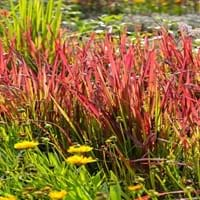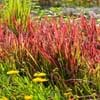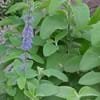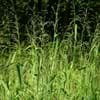Life Span
Perennial
Perennial
Origin
Japan
North America, United States, Northeastern United States, Mid-Atlantic United States, Southeastern United States, Canada
Types
Not Available
Red chokeberry, Purple chokeberry
Habitat
Moist Soils, River side, yards
Anthropogenic, Boggy areas, Cliffs, Fens, Swamps, Terrestrial, Wet lands, Woodlands
USDA Hardiness Zone
5-9
3-8
Sunset Zone
2b, 3a, 3b, 4, 5, 6, 7, 8, 9, 10, 11, 12, 13, 14, 15, 16, 17, 18, 19, 20, 21, 22, 23, 24
A2, A3, 1a, 1b, 2a, 2b, 3a, 3b, 4, 5, 6, 7
Habit
Upright/Erect
Thicket/Colonizing
Flower Color
Not Available
Not Available
Flower Color Modifier
Bicolor
Not Available
Fruit Color
Non Fruiting Plant
Purplish-black
Leaf Color in Spring
Light Green
Not Available
Leaf Color in Summer
Light Green
Not Available
Leaf Color in Fall
Green, Sienna
Not Available
Leaf Color in Winter
Tan
Not Available
Leaf Shape
Subulate
Elliptic
Plant Season
Not Available
Spring, Summer, Fall
Sunlight
Full Sun, Partial Sun
Full Sun, Partial Sun, Partial shade
Type of Soil
Clay, Loam, Sand
Clay, Loam
The pH of Soil
Acidic, Neutral, Alkaline
Acidic, Neutral, Alkaline
Soil Drainage
Average
Average
Bloom Time
Late Summer
Late Spring, Early Summer
Tolerances
Drought, Salt
Not Available
Where to Plant?
Ground
Ground, Pot
How to Plant?
From Rhizomes, Seedlings
Cuttings, Divison, Seedlings
Plant Maintenance
Medium
Medium
Watering Requirements
Average Water Needs, Keep the ground moist but not water-logged
Average Water Needs, Do Not over Water, Requires regular watering
In Summer
Lots of watering
Lots of watering
In Spring
Moderate
Moderate
In Winter
Average Water
Average Water
Soil pH
Acidic, Neutral, Alkaline
Acidic, Neutral, Alkaline
Soil Type
Clay, Loam, Sand
Clay, Loam
Soil Drainage Capacity
Average
Average
Sun Exposure
Full Sun, Partial Sun
Full Sun, Partial Sun, Partial shade
Pruning
Prune once the plant is tall enough, Remove damaged leaves, Remove dead branches, Remove dead leaves
Prune after flowering, Remove branches that rub together, Remove damaged leaves, Remove dead branches, Remove dead leaves, Remove diseased branches by the tool's blades dipped into the alcohol solution
Fertilizers
can go long without fertilizers, Doesn't require fertilization when grown in rich soil
10-10-10, All-Purpose Liquid Fertilizer, Apply N-P-K
Pests and Diseases
Not Available, Red blotch
Red blotch
Plant Tolerance
Deer resistant, Drought, Full Sun, Shade areas
Not Available
Flowers
Insignificant
Yes
Flower Petal Number
Single
Not Available
Foliage Texture
Medium
Not Available
Foliage Sheen
Matte
Not Available
Attracts
Not Available
Not Available
Allergy
Not Available
Anaphylaxis
Aesthetic Uses
Ground Cover
Showy Purposes
Beauty Benefits
Not Available
Good for skin
Edible Uses
Not Available
Yes
Environmental Uses
Air purification
Air purification, Food for birds, Wildlife
Medicinal Uses
Not Available
anti-cancer, Antioxidants, Cold
Part of Plant Used
Leaves, Root
Fruits
Other Uses
Traditional medicine, Weaving into Mats and Bags
Pectin
Used As Indoor Plant
Yes
No
Used As Outdoor Plant
Yes
Yes
Garden Design
Not Available
Foundation, Mixed Border
Botanical Name
IMPERATA cylindrica
ARONIA melanocarpa
Common Name
Japanese Blood Grass
Black Chokeberry
In Hindi
Japanese Blood Grass
Black Chokeberry Shrub
In German
Japanische Blut Grass
Schwarz Aronia Strauch
In French
Herbe de sang japonais
Noir Chokeberry Arbuste
In Spanish
Hierba de sangre japonesa
Chokeberry negro Arbusto
In Greek
Ιαπωνικά Grass αίματος
Μαύρο Chokeberry θάμνων
In Portuguese
Grama sangue japonês
Chokeberry preto Arbusto
In Polish
Japoński Krew Trawa
Krzew aronii
In Latin
Sanguinem Italica Grass
Lichen Frutex
Phylum
Magnoliophyta
Magnoliophyta
Class
Liliopsida
Magnoliopsida
Clade
Angiosperms, Commelinids, Monocots
Angiosperms, Eudicots, Rosids
Tribe
Not Available
Maleae
Subfamily
Not Available
Amygdaloideae
Number of Species
Not Available
Not Available
Importance of Japanese Blood Grass and Black Chokeberry
Want to have the most appropriate plant for your garden? You might want to know the importance of Japanese Blood Grass and Black Chokeberry. Basically, these two plants vary in many aspects. Compare Japanese Blood Grass and Black Chokeberry as they differ in many characteristics such as their life, care, benefits, facts, etc. Every gardener must at least have the slightest clue about the plants he wants to plant in his garden. Compare their benefits, which differ in many ways like facts and uses. The medicinal use of Japanese Blood Grass is Not Available whereas of Black Chokeberry is anti-cancer, Antioxidants and Cold. Japanese Blood Grass has beauty benefits as follows: Not Available while Black Chokeberry has beauty benefits as follows: Not Available.
Compare Facts of Japanese Blood Grass vs Black Chokeberry
How to choose the best garden plant for your garden depending upon its facts? Here garden plant comparison will help you to solve this query. Compare the facts of Japanese Blood Grass vs Black Chokeberry and know which one to choose. As garden plants have benefits and other uses, allergy is also a major drawback of plants for some people. Allergic reactions of Japanese Blood Grass are Not Available whereas of Black Chokeberry have Anaphylaxis respectively. Having a fruit bearing plant in your garden can be a plus point of your garden. Japanese Blood Grass has no showy fruits and Black Chokeberry has showy fruits. Also Japanese Blood Grass is not flowering and Black Chokeberry is flowering. You can compare Japanese Blood Grass and Black Chokeberry facts and facts of other plants too.





